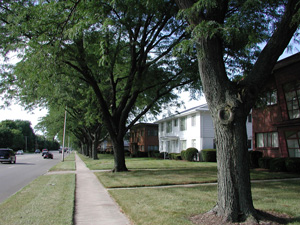Resource Library
Plant of the Week: Moraine Honeylocust
The University of Arkansas System Division of Agriculture does not promote, support or recommend plants featured in "Plant of the Week." Please consult your local Extension office for plants suitable for your region.
Plant of the Week
Moraine Honeylocust
Latin: Gleditsia triacanthos

Trees are the largest plants in the landscape and help define the space better than any other single element. Because they have such an impact on the landscape, the decision of which trees to retain in a wooded landscape and which trees to add is very important. That there is such a thing as the “best tree” is an illusion but, that doesn’t stop the claims from being made. Moraine Honeylocust (Gleditsia triacanthos var. inermis), the first patented shade tree, was in its day considered one of the best trees.
Moraine honeylocust is a round-headed deciduous shade tree in the legume family that grows to about 50 feet tall and wide. It has deep green, finely divided compound leaves to 8 inches long with the 20 or so oval leaflets about one-half inch long. Fall color is golden yellow.
The variety name “inermis” identifies this as a thornless honeylocust, an important consideration because the typical thorn bearing honeylocust has wicked looking branched thorns on its trunk that can be as much as 8 inches long and designed to stop browsing by hungry pachyderms. In addition to being thornless, Moraine is also a fruitless selection.
The Plant Patent Act of 1930, like much national legislation, was a long time in coming, first being promoted by the American nursery trade association in 1891. However, progress was slow and it required the dedicated effort of Paul Stark, beginning in 1923, a member of the old-line Missouri fruit tree nursery family and the support of luminaries such as Luther Burbank, and his wife after he died; L. H. Bailey and Thomas Edison to see the legislation finally passed. This legislation gave patent protection for 17 years (now 20) years for breeders who developed new and useful plants. Plant patents could be held by the developer or rights assigned to licensed propagators so long as a royalty was paid to the patent holder. International treaties on plant patents were adopted first in 1957 and have been continually updated.
Moraine honeylocust was issued Plant Patent 836 in 1949 to the Siebenthaler Company of Dayton, Ohio. The nursery is still in operation and is being run by the fifth and sixth generation family members. The tree was discovered just after WWII when Clarence Siebenthaler was driving his son Bob back to college. They collected bud wood and propagated the plant and found the traits to remain true after budding. Moraine is a small town adjacent to Dayton where the firm had a 140-acre field production nursery. Moraine honeylocust proved to be a popular tree in part because of the post-war expansion that was occurring and because Dutch elm disease was denuding whole communities across the Midwest as it killed stately hundred-year- old American elms. At its height of popularity, 75,000 of the honeylocust trees were sold a year.
Since Moraine was patented, many other nurseries patented their own honeylocust cultivars, and as too often happens, honeylocusts became over-represented in the urban landscape of the Midwest. Though it never reached the monoculture of the American Elm, this mass planting lead to a proliferation of insect pests -- especially webworms and borers -- and a serious canker disease that turned the once highly revered “best” tree to trash tree status 30 years later.
Moraine honeylocust is still a good tree, and according to plantsman Mike Dirr, probably the cultivar against which all other new introductions should be measured. However, it should be planted in moderation, preferably as a part of a mixed shade tree stand, not as a single species used as some sort of sweeping array of one species.
As a shade tree Moraine is desirable because it casts light shade and lawn grasses can grow beneath it with relatively little effect and the tree is deep rooted enough to not overly compete with shrubs and flowers planted near it. It is hardy from zones 4 through 9 but admittedly does better in the cooler end of the range than in the heat and humidity of the South.
By: Gerald Klingaman, retired
Retired Extension Horticulturist - Ornamentals
Extension News - January 11, 2013
The University of Arkansas System Division of Agriculture does not maintain lists of retail outlets where these plants can be purchased. Please check your local nursery or other retail outlets to ask about the availability of these plants for your growing area.